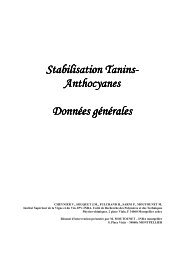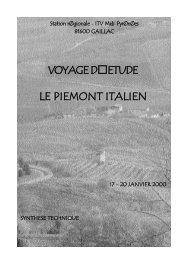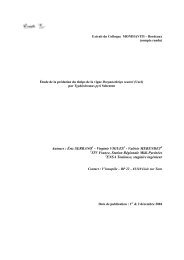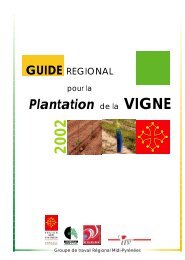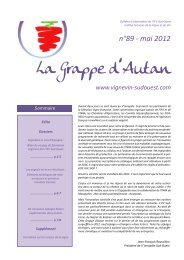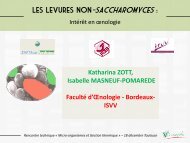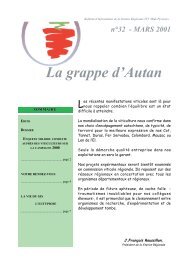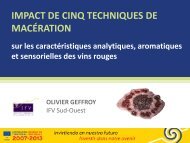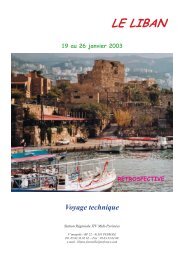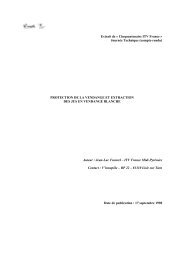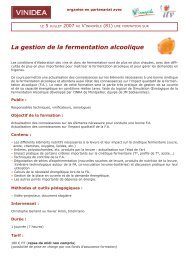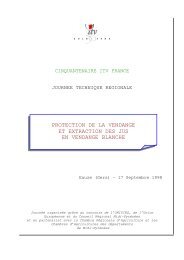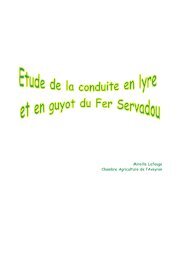Bioconversion de l'acide p-coumarique par Brettanomyces ...
Bioconversion de l'acide p-coumarique par Brettanomyces ...
Bioconversion de l'acide p-coumarique par Brettanomyces ...
Create successful ePaper yourself
Turn your PDF publications into a flip-book with our unique Google optimized e-Paper software.
Author's personal copy1664 D. Salameh et al. / Food Chemistry 107 (2008) 1661–1667served as a witness test. All these experiments were done ata temperature of 30 °C.2.6. Yeast countingBiomass concentration was followed up by two analyticaltechniques. A correlation between the optical <strong>de</strong>nsity ofyeast suspension at 620 nm and cell dry weight gives weightconcentration, and the use of a Thoma hemacytometergives a concentration in number of cells. The percentageof viable cells is obtained using the ethylene blue stainingmethod, with an error of 8%.3. Results and discussion3.1. p-Coumaric acid stability in the air oxygen un<strong>de</strong>r daylightThe results showed that there was no significant changein absorbance after 10 days. It seems that the p-coumaricacid is stable in daylight, at ambient temperature and inthe presence of oxygen un<strong>de</strong>r experimental conditions.3.2. Thermo<strong>de</strong>gradation test of p-coumaric acidThe purpose of this test was to study the stability of thep-coumaric acid with temperature. The results showed thatthere was no change in UV absorbance during 30 h un<strong>de</strong>rambient temperature, while the absorbance <strong>de</strong>creased whenthe temperature was 75 °C (Fig. 1). The absorbance<strong>de</strong>creased by 26% (from 0.65 down to 0.481) when the p-coumaric acid solution was autoclaved. As a control, theabsorbance of a wine synthetic medium, free from the acid,was followed up before and after autoclaving. The absorbanceremained constant: 0.3 abs value.These tests showed that p-coumaric acid in solutions,<strong>par</strong>ticularly in natural wine un<strong>de</strong>r oenological conditions,is quite stable at ambient temperature. On the other hand,it is unstable when temperature increases. We confirm theresults of Bagchi et al., 1997 and Herrera et al., 1998. Practically,it would be important to add the p-coumaric acid insynthetic wine media after autoclaving in or<strong>de</strong>r to be surethat all the p-coumaric acid will be available in its naturalform for enzymatic reactions.3.3. Reactivity tests of the p-coumaric acid in the mediaIt is difficult to dissolve p-coumaric crystalline pow<strong>de</strong>r inpure distilled water. When it is dissolved, the p-coumaricacid takes filamentous form within 40 h. Authors proposedin their work the dissolution of p-coumaric acid in ethanolwhich is a potent solvent. On the other hand, Tuzen andOz<strong>de</strong>mir (2003) proposed the dissolution of p-coumaricacid into hydroalcoholic solutions.The observations showed that p-coumaric acid dissolvesslower in hydroalcoholic solutions than in pure ethanolsolution (Fig. 2). But they showed also that there was a lossof p-coumaric acid quantity relative to 0.2 absorbance unit,when dissolving into pure ethanol, which leads to thinkthat a probable ethanol/p-coumaric acid reaction couldtake place. The study of p-coumaric acid UV absorbancein the media <strong>de</strong>tailed in the material and methods <strong>par</strong>t(Media A–F), confirmed this hypothesis. It gave the followingresults.In the range studied, Medium A showed no absorption.Medium B showed two absorption bands at 285 nm and305 nm. On the other hand, media C and D showedremarkable hypsochrome and hypochrome effect. Themaximum wavelength absorption <strong>de</strong>creased from 284 nm(Medium B) to 248 nm (Medium C), and the band becamelarger.The hypochrome effect could result from a <strong>de</strong>stabilizationof the mesomeric system which minimizes the absorptionprobability of the carbonyl group. The hypsochromeeffect could result even from the polarity change of the solventor from any change in the p-coumaric acid structure.Moreover, this peak shift occurred more slowly (24 h) inMedium D, where the medium had a little ethanol concentration(10% v/v ethanol). These observations lead to thinkthat some reactions between the p-coumaric acid and theethanol might take place and that the concentration of ethanol<strong>par</strong>ticipates in its kinetics.0.850.8Absorbance0.70.680.660.640.620.60.580.560.540.520 5 10 15 20 25 30Time (h)Fig. 1. Absorbance as a function of time at ambient temperature 20 °C()and 75 °C (h) in synthetic wine medium.Absorbance0.750.70.650.60.550.50.450.40 20 40 60 80 100Time (h)Fig. 2. Kinetic profile of the dissolution of p-coumaric acid in ethanol ()and synthetic wine medium (h).



